Parameters and characteristics of electromagnets
Basic characteristics of electromagnets
The most common are dynamic characteristics that account for changes in n. c. electromagnet in the process of its work due to the action of EMF of self-induction and movement, and also take into account friction, damping and inertia of moving parts.
For some species electromagnets (high-speed electromagnets, electromagnetic vibrators, etc.) knowledge of the dynamic characteristics is mandatory, since only they characterize the working process of such electromagnets. However, obtaining dynamic features requires a lot of computational work. Therefore, in many cases, especially when accurate travel time determination is not required, they are limited to reporting static characteristics.
 The static characteristics are obtained if we do not take into account the effect on the electric circuit of the back EMF occurring during the movement of the armature of the electromagnet, i.e. we assume that the current in the coil of the electromagnet is unchanged and equal, for example, to the operating current.
The static characteristics are obtained if we do not take into account the effect on the electric circuit of the back EMF occurring during the movement of the armature of the electromagnet, i.e. we assume that the current in the coil of the electromagnet is unchanged and equal, for example, to the operating current.
The most important characteristics of the electromagnet from the point of view of its preliminary evaluation are the following:
1. Traction static characteristic of the electromagnet... It represents the dependence of the electromagnetic force on the position of the armature or the working gap for different constant values of the voltage supplied to the coil or the current in the coil:
Fe = f (δ) at U = const
or Fe = f (δ)in I= const.
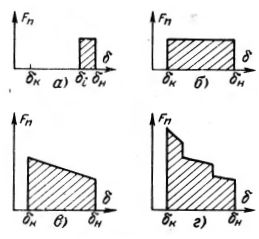 Rice. 1. Typical types of electromagnetic loads: a — locking mechanism, b — when lifting a load, c — in the form of a spring, d — in the form of a series of input springs, δn — initial clearance, δk is the final clearance.
Rice. 1. Typical types of electromagnetic loads: a — locking mechanism, b — when lifting a load, c — in the form of a spring, d — in the form of a series of input springs, δn — initial clearance, δk is the final clearance.
2. Characteristic of the opposing forces (load) of the electromagnet... It represents the dependence of the opposing forces (in the general case, reduced to the point of application of the electromagnetic force) on the working gap δ (Fig. 1): Fn = f (δ)
The comparison of the opposite and traction characteristics makes it possible to draw a conclusion (preliminarily, without taking into account the dynamics) about the operability of the electromagnet.
In order for the electromagnet to work normally, it is necessary that the traction characteristic in the entire range of changes in the course of the armature pass above the opposite one, and for a clear release, on the contrary, the traction characteristic must pass below the opposite one (Fig. 2).
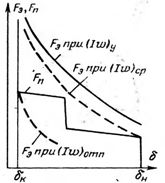
Rice. 2. Towards the coordination of the characteristics of the active and opposing forces
3. Load characteristic of the electromagnet... This characteristic relates the value of the electromagnetic force and the magnitude of the voltage applied to the coil or the current in it with a fixed position of the armature:
Fe = f (u) and Fe = f (i) in δ= const
4.Conditionally useful work electromagnet... It is defined as the product of the electromagnetic force corresponding to the initial operating gap by the value of the armature stroke:
Wny = Fn (δn — δk) in Аz= const.
The value of the conditional useful work for a given electromagnet is a function of the initial position of the armature and the magnitude of the current in the electromagnet coil. In fig. 3 shows the characteristic of static traction Fe = f (δ) and curve Wny = Fn (δ) electromagnet. The shaded area is proportional to Wny at this value of δn.
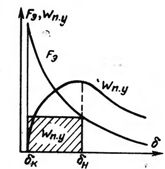
Rice. 3… Conditionally useful operation of an electromagnet.
5. Mechanical efficiency of an electromagnet — the relative value of the conditional useful work Wny compared to the maximum possible (corresponding to the largest shaded area) Wp.y m:
ηfur = Wny / Wp.y m
When calculating an electromagnet, it is advisable to choose its initial clearance in such a way that the electromagnet gives the maximum useful work, i.e. δn corresponds to Wp.ym (Fig. 3).
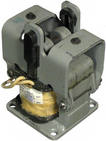 6. Response time of an electromagnet — the time from the moment the signal is applied to the coil of the electromagnet until the transition of the armature in its final position. All other things being equal, this is a function of the initial opposing force Fn:
6. Response time of an electromagnet — the time from the moment the signal is applied to the coil of the electromagnet until the transition of the armature in its final position. All other things being equal, this is a function of the initial opposing force Fn:
TSp = f (Fn) at U = const
7. Heating characteristic is the dependence of the heating temperature of the electromagnet coil on the duration of the on state.
8. Q-factor of an electromagnet, defined as the ratio of the mass of the electromagnet to the value of the conditional useful work:
D = mass of electromagnet / Wpu
9.Profitability index, which is the ratio of the power consumed by the electromagnet coil to the value of the conditional useful work:
E = consumed power / Wpu
All these characteristics make it possible to establish the suitability of a given electromagnet for certain conditions of its operation.
Electromagnetic parameters
In addition to the characteristics listed above, we will also consider some of the main parameters of electromagnets. These include the following:
a) Power consumed by the electromagnet... The limiting power consumed by an electromagnet can be limited both by the amount of allowable heating of its coil and in some cases by the circuit power conditions of the coil of the electromagnet.
For power electromagnets, as a rule, the limitation is its heating during the switch-on period. Therefore, the amount of allowable heating and its correct accounting are as important factors in the calculation as the given force and stroke of the armature.
The choice of a rational design, both in magnetic and mechanical terms, as well as in terms of thermal characteristics, makes it possible, under certain conditions, to obtain a design with minimum dimensions and weight and, accordingly, the lowest price. The use of more advanced magnetic materials and winding wires also contributes to increasing design efficiency.
 In some cases, electromagnets (for relay, regulators, etc.) are designed on the basis of achieving maximum effort, i.e. the minimum energy consumption for a given useful operation. Such electromagnets are characterized by relatively small electromagnetic forces and shocks and light moving parts.The heating of their windings is much lower than permissible.
In some cases, electromagnets (for relay, regulators, etc.) are designed on the basis of achieving maximum effort, i.e. the minimum energy consumption for a given useful operation. Such electromagnets are characterized by relatively small electromagnetic forces and shocks and light moving parts.The heating of their windings is much lower than permissible.
Theoretically, the power consumed by an electromagnet can be arbitrarily reduced by correspondingly increasing the size of its coil. Practically, the limit to this is created by the increasing length of the average turn of the coil and the length of the center line of the magnetic induction, with the result that increasing the size of the electromagnet becomes inefficient.
b) Safety factor… In most cases n. v. initiation can be considered equal to n. c. actuation of an electromagnet.
The relation of n. c. corresponding to the stationary value of the current, k n. with actuation (critical N.S.) (see Fig. 2) is called the safety factor:
ks = Azv / AzSr
The safety factor of an electromagnet, according to reliability conditions, is always chosen more than one.
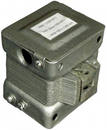 v) A trigger parameter is the minimum value of n. c. current or voltage at which the electromagnet is actuated (moving the armature from δn to δDa se).
v) A trigger parameter is the minimum value of n. c. current or voltage at which the electromagnet is actuated (moving the armature from δn to δDa se).
G) Release parameter — the maximum value of n, respectively. s, current or voltage at which the armature of the electromagnet returns to its original position.
e) Percentage of return… The ratio of n.c at which the armature returns to its original position, to n. c. actuation is called the return coefficient of the electromagnet: kv = Азv / АзСр
For neutral electromagnets, the values of the coefficient of return are always less than one, and for different designs they can be from 0.1 to 0.9. At the same time, achieving values close to both limits is equally difficult.
The coefficient of return is of greatest importance when the opposite characteristic is as close as possible to the pull characteristic of the electromagnet. Decreasing the solenoid stroke also increases the return rate.
